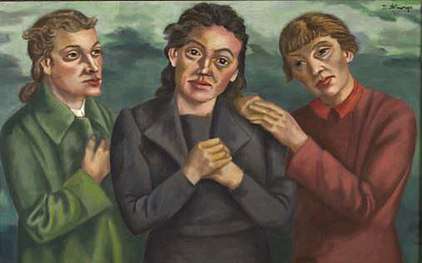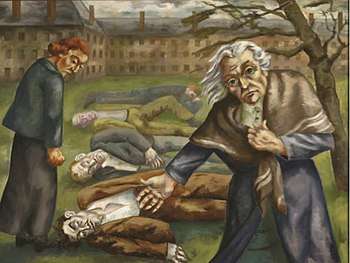Peter Ludwigs
Peter Ludwigs (16 February 1888, Aachen - 3 July 1943, Düsseldorf) was a German sculptor and Expressionist painter. He is primarily known for his later, Anti-fascist paintings.

Biography
He was born into an old family of manufacturers. Initially, he studied sculpture at the Werkkunstschule Aachen (a Kunstgewerbeschule) and the Académie Royale des Beaux-Arts in Brussels. In 1911, he moved to Düsseldorf and got married. From 1915 to 1918, he was a voluntary participant in World War I, an experience that left him opposed to militarism. A year after his return, he joined the left-wing Aktivistenbund 1919 ("Neuen Gesellschaft für künstlerische Kultur"). He was also one of the co-founders of "Young Rhineland".[1] During this time, he turned from sculpture to painting; with an emphasis on social commentary.
In 1922, he became a member of the Communist Party of Germany (KPD). Two years later, he was one of the co-founders of the satirical journal Die Peitsche (the whip). Together with Karl Schwesig and Gert Heinrich Wollheim, he published cartoons and graphics in opposition to militarism and supporting "class justice". He and several other left-leaning German painters also participated in the "First General Art Exhibition" in Moscow (1924). After "Young Rhineland" broke up, he became a board member of its successor, the "Rhenish Secession". In 1929 he, Schwesig, Mathias Barz, Hanns Kralik, Julo Levin, Carl Lauterbach and the actor/director Wolfgang Langhoff created the Association of Revolutionary Visual Artists (known in German as ASSO).
After Hitler's rise to power in 1933, his paintings were classified as "degenerate art" and banned from being shown in public.[2] Cut off from his livelihood and increasingly impoverished, he joined the Resistance and distributed illegal Communist pamphlets. He also became part of a group of Anti-fascist artists in Düsseldorf, who offered each other mutual financial support and protection, centered around the painter, Otto Pankok. His activities put him under constant surveillance by the Gestapo and he was arrested in 1937, on suspicion of high treason, but released in 1938.
In February, 1943, he was arrested again and sent to Düsseldorf Prison, where he was assigned to a labor gang doing heavy road-clearing work. A combination of exhaustion and insulin deprivation (he was diabetic) caused his death in July.[3]
In 1962, a monument was erected in the Golzheimer Friedhof, commemorating Ludwigs, Julo Levin and Franz Monjau.[4] A stolperstein was later placed at his residence in Düsseldorf.[5] Thirty of his paintings are on display at the Museum Kunstpalast.[6]
Selected paintings
 Working Family at the Table (Mealtime)
Working Family at the Table (Mealtime) The War
The War War Widows
War Widows Mother B. (at Düsseldorf Prison)
Mother B. (at Düsseldorf Prison)
References
- Am Anfang war die Ey, Foto: Peter Ludwigs und Johanna Ey, Foto Stadtmuseum Landeshauptstadt Düsseldorf
- Datenbank beschlagnahmte Kunst: Peter Ludwgs, from the Datenbank zum Beschlagnahmeinventar der Aktion "Entartete Kunst", Forschungsstelle "Entartete Kunst", FU Berlin
- Besatzungszeit und Nationalsozialismus: 19. Peter Ludwigs (PDF), in Museumszeitung Zeitung Nr. 04, 2009, Stadtmuseum Landeshauptstadt Düsseldorf
- "Golzheim (Düsseldorf-)/Gedenkstein Maler". GenWiki. 2007-11-30. Retrieved 2017-07-17.
- Christine Zacharias: Vernachlässigte Stolpersteine, in Rheinische Post vom 15. Juli 2011, abgerufen am 10. Mai 2016.
- „Von Künstlern, die im Rheinland aktiv waren, besitzt die Sammlung nicht selten größere Konvolute – in der Kunst vor dem Zweiten Weltkrieg beispielsweise gut 30 Gemälde von Peter Ludwigs“ (PDF), auf rak-bonn.de, in Zum Werknachlass des Malers Walter Ophey (1882–1930) im Museum Kunstpalast, abgerufen am 10. Mai 2016
External links
| Wikimedia Commons has media related to Peter Ludwigs. |
- Peter Ludwigs, Data at RKD (Rijksbureau voor Kunsthistorische Documentatie)
- Gerda Kaltwasser: Peter Ludwigs – ein verfolgter Künstler. Rheinische Post, Düsseldorfer Stadtpost, 23 January 1982, from Frauen-Kultur-Archiv
- Johanna Ey, "Peter Ludwigs, Robert Pudlich, Luzie Uptmoor im Eingang der Galerie", in the Stadtmuseum Düsseldorf
- Peter Ludwigs, Life and work @ Memoriart